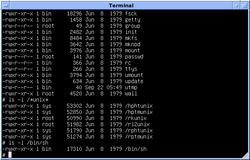History

The command-line interface evolved from a form of dialog once conducted by humans over teleprinter (TTY) machines, in which human operators remotely exchanged information, usually one line of text at a time. Early computer systems often used teleprinter machines as the means of interaction with a human operator. The computer became one end of the human-to-human teleprinter model. So instead of a human communicating with another human over a teleprinter, a human communicated with a computer.
The mechanical teleprinter was replaced by a "glass tty", a keyboard and screen emulating the teleprinter. "Smart" terminals permitted additional functions, such as cursor movement over the entire screen, or local editing of data on the terminal for transmission to the computer. As the microcomputer revolution replaced the traditional – minicomputer + terminals – time sharing architecture, hardware terminals were replaced by terminal emulators — PC software that interpreted terminal signals sent through the PC's serial ports. These were typically used to interface an organization's new PC's with their existing mini- or mainframe computers, or to connect PC to PC. Some of these PCs were running Bulletin Board System software.
Early operating system CLIs were implemented as part of resident monitor programs, and could not easily be replaced. The first implementation of the shell as a replaceable component was part of the Multics time-sharing operating system. In 1964, MIT Computation Center staff member Louis Pouzin developed the RUNCOM tool for executing command scripts while allowing argument substitution. Pouzin coined the term "shell" to describe the technique of using commands like a programming language, and wrote a paper about how to implement the idea in the Multics operating system. Pouzin returned to his native France in 1965, and the first Multics shell was developed by Glenda Schroeder.
The first Unix shell, the V6 shell, was developed by Ken Thompson in 1971 at Bell Labs and was modeled after Schroeder's Multics shell. The Bourne shell was introduced in 1977 as a replacement for the V6 shell. Although it is used as an interactive command interpreter, it was also intended as a scripting language and contains most of the features that are commonly considered to produce structured programs. The Bourne shell led to the development of the KornShell (ksh), Almquist shell (ash), and the popular Bourne-again shell (or Bash).
Early microcomputers themselves were based on a command-line interface such as CP/M, DOS or AppleSoft BASIC. During the 1980s and 1990s, the introduction of the Apple Macintosh and of Microsoft Windows on PCs saw the command line interface as the primary user interface replaced by the Graphical User Interface. The command line remained available as an alternative user interface, often used by system administrators and other advanced users for system administration, computer programming and batch processing.
In November 2006, Microsoft released version 1.0 of Windows PowerShell (formerly codenamed Monad), which combined features of traditional Unix shells with their proprietary object-oriented .NET Framework. MinGW and Cygwin are open-source packages for Windows that offer a Unix-like CLI. Microsoft provides MKS Inc.'s ksh implementation MKS Korn shell for Windows through their Services for UNIX add-on.
Since 2001, the Macintosh operating system macOS has been based on a Unix-like operating system called Darwin. On these computers, users can access a Unix-like command-line interface by running the terminal emulator program called Terminal, which is found in the Utilities sub-folder of the Applications folder, or by remotely logging into the machine using ssh. Z shell is the default shell for macOS; bash, tcsh, and the KornShell are also provided. Before macOS Catalina, bash was the default.
Comments
Post a Comment